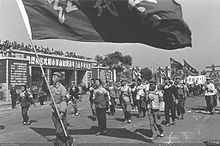- Down to the Countryside Movement
-
Down to the Countryside Movement 
Photo from 1968. 200,000 youth in Shenyang were recruited to the countryside to live and work Traditional Chinese 上山下鄉運動 Simplified Chinese 上山下乡运动 Literal meaning Up to the mountains and down to the villages Transcriptions Mandarin - Hanyu Pinyin Shàngshān xiàxiāng yùndòng Cantonese - Jyutping soeng5saan1 haa6hoeng1 wan6dung6 The Down to the Countryside Movement (Chinese: 上山下乡运动) was a policy instituted in the People's Republic of China in the late 1960s and early 1970s. As a result of the anti-bourgeois thinking prevalent during the Cultural Revolution, Mao Zedong declared certain privileged urban youth would be sent to mountainous areas or farming villages, in order that they could learn from the workers and farmers there.
Mao's policy differed from Liu Shaoqi's early 1960s sending-down policy, for its political context. Liu Shaoqi instituted the first sending-down policy to redistribute excess urban population following the Great Chinese Famine and the Great Leap Forward. Mao's use of the policy sent-down the Red Guards who had risen up at his beck and call, sending China into chaos. Essentially, Mao used the "up to the mountains and down to the villages" to quell unrest and remove the embarrassment of the early Cultural Revolution from sight.
As a result, many fresh high school graduates, who became known as the Rusticated Youth of China, were forced out of the cities and effectively exiled to remote areas of China. Some commentators consider these people, many of whom lost the opportunity to attend university, China's "lost generation." Famous authors who have written about their experiences during the movement include Nobel Laureate Liu Xiaobo, Jiang Rong, and Zhang Chengzhi, both of whom went to Inner Mongolia.
See also
References
- Schoppa, R. Keith (2006), Revolution and Its Past: Identities and Change in Modern Chinese History, Pearson Education, pp. 349–356, ISBN 0-13-193039-7
- Benson, Linda (2002), China Since 1949, Semnar Studies in History, Pearson Education, pp. 38–44, ISBN 0-582-43739-3
- Zhong, Xueping; et. al. (2001), Some of Us: Chinese Women Growing Up in the Mao Era, Rutgers University Press, ISBN 0-8135-2969-7
The Cultural Revolution
(1966–1976)Major events Socialist Education Movement · Lushan Conference · Down to the Countryside Movement · Wuhan Incident · 9th Party Congress · Project 571 Outline · Criticize Lin, Criticize Confucius · Tiananmen IncidentKey figures Mao Zedong · Liu Shaoqi · Zhou Enlai · Lin Biao · Deng Xiaoping · Gang of Four (Jiang Qing · Zhang Chunqiao · Yao Wenyuan · Wang Hongwen) · Peng Dehuai · Wu Han · Peng Zhen · Chen Boda · Wang Dongxing · Xie Fuzhi · Kang Sheng · Mao YuanxinDocuments Concepts Four Olds · Struggle session · Feudal Fascism · Two Whatevers · Big-character poster · One Divides Into Two · Democracy Wall · Eight model plays · Scar literature · Capitalist roaderGroups Red Guards · Cultural Revolution Group · Revolutionary Committee · Shanghai People's Commune · 8341 Special Regiment · The Rusticated Youth of ChinaRelated topics History portal Categories:- Cultural Revolution
- Maoist terminology
- History of the People's Republic of China
- Maoist China
- People's Republic of China stubs
Wikimedia Foundation. 2010.
